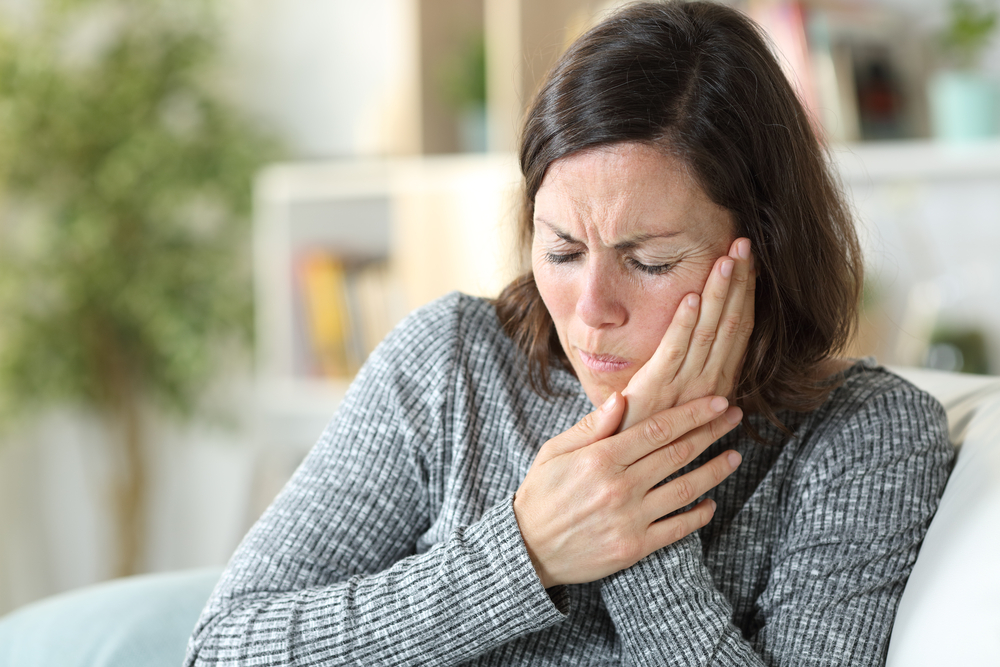5 Solutions for TMJ Pain Relief

Does jaw pain keep you from enjoying your favorite foods? Most jaw pain is caused by inflammation, injury, or overworking of the joints, muscles, and ligaments that attach your jaw to your skull. These Temporomandibular Joints typically heal over time, but debilitating injuries and chronic bad habits can lead to chronic temporomandibular joint disorder (TMD).
If you want to break the cycle and stop your joint pain indefinitely, you may need to take a look at your habits. Don’t just consider the eating habits that contribute to tooth decay. You should also be considering other activities that might be leading to the chronic TMD.
Clenching teeth under stress or from chronic pain, as well as grinding teeth during sleep can cause severe jaw pain over a prolonged period of time. Other symptoms of TMJ disorders are pain in the ears, face, and headaches, as well as possible locking or clicking of the TMJ joints.
You may also experience TMJ pain if you have oral fixation habits, such as chewing gum, hard candies, straws, pens, or anything else that is handy. Breaking such habits is necessary if you want to stop joint pain from returning.
Here are 5 things you can do to relieve the pain while you are working on addressing the main underlying issue.
Trigger point massage
Trigger points are like the knots you get in other muscles in your body. These muscles, in this case the masseter muscle, which covers the jaw over your teeth, can be relaxed through massage in the same way. A licensed professional like a chiropractor, physical therapist, massage therapist, or osteopathic physician should perform the massage for the maximum benefit.
Jaw exercises
If you have weakened or overworked the muscles in your jaw, you can restore them to health the same way you would any other muscle or joint in your body. Jaw exercises, which you can learn from a physical therapist, will allow you to return those muscles to a state of health while decreasing pain. As with any physical therapy, the exercises you do at home are vital for recovery.
Posture correction
While you are at the physical therapist, you should also request services for posture correction. Even if it is not part of your treatment plan for your jaw pain (although it should be), posture correction can help all of the joints in your body. Correcting your posture can even reduce or eliminate headaches and joint pain.
Relaxation practices
Most often, chewing and teeth clenching are the result of stress, anxiety, pain, or a combination of these. Rather than just treating the jaw pain, you need to learn how to cope with the stress in another way. Practicing relaxation techniques when you notice your jaw tensing or your teeth working will help you stop the behavior so that further treatment is not necessary.
When most people think about relaxation they think of practices like meditation, but that isn’t your only option. Relaxation practices can be as simple as taking a few deep breaths while mindfully taking in your surroundings. You can find many guided meditations of just a few minutes each online.
Alternating hot and cold compresses
Are you confused about whether you should be using hot or cold compresses on your sore jaw joints? The answer is both! Treating TMJ requires both decreasing inflammation and relieving pain, and it takes both hot and cold compresses to make that happen.
A cold compress will take down swelling and dull nerve pain a bit, while a hot compress will relax the jaw muscles and improve circulation for healing. Start with the cold compress for 15 to 20 minutes, but not directly against your skin. Then you can relieve additional pain and soreness with about the same amount of time with a cold compress.
